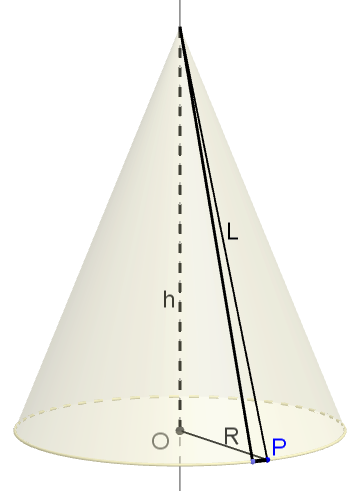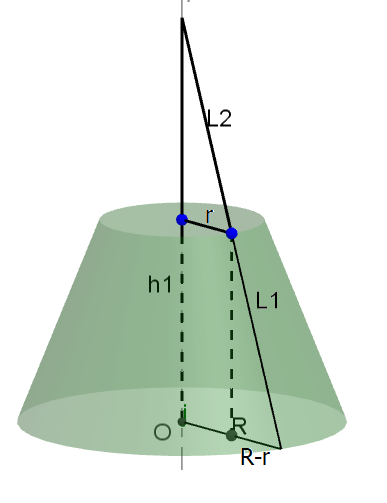Lateral Area of a Cone

Figure 1 shows a cone and we want a formula for the surface area, excluding the base. If the base area were desired, we know that to be $\pi R^{2}$ and it could just be added. The skinny triangle in Fig 1 is drawn with such a short base that a good approximation of its height is the length of one side, $L$. Therefore, its area is $$A_{triangle}\approx \frac{1}{2}\cdot base\cdot L$$ If there were many of these triangles, each with base, $b_{1},b_{2},...,b_{n}$, we could add them all up to get an approximation of the surface area. $$Area \approx \frac{b_{1}L}{2}+\frac{b_{2}L}{2}+...+\frac{b_{n}L}{2}$$ Factoring out $L/2$, $$A \approx \frac{1}{2}L\left[b_{1}+b_{2}+...+b_{n}\right]$$ Of course if we could draw infinitely many triangles, their summed base length would be the circumference of the circle, and the approximation would become exact. $$Area=\frac{1}{2}\cdot L\cdot2\pi R=\pi RL\tag{1} \label{1}$$
Frustum of a Cone

Equation for the surface area of any circular base cone. $$\mathbf{\text{Area}=\frac{1}{2}L\cdot2\pi R=\pi R L} \tag{1}$$ $$\pi R(L_1 + L_2) \Leftarrow \text{Complete Cone Surface of Fig 2}$$ $$\pi r L_2 \Leftarrow \text{Invisible Top Cone Surface}$$ $$\text{Frustum Surface Area}=\pi R(L_1+L_2)-\pi r L_2$$ I suppose we could stop here, but $L_2$, being invisible and all, could be tricky to measure. What's more, we have an expression, Eq.$\eqref{5}$ that would permit a substitution to get the area in terms of $L_1,R,\text{ and }r$. So let's do that algebra. Start with the substitution. $$\pi R\left(L_1+\frac{rL_1}{R-r}\right)-\pi r\left(\frac{rL_1}{R-r}\right)$$ Now expand the parenthesis and get over a common denominator. $$ \frac{\pi R L_1(R-r)}{R-r} + \pi R \left(\frac{rL_1}{R-r}\right) -\pi r\left(\frac{rL_1}{R-r}\right) $$ So expand it again. $$ \frac{\pi R^2 L_1}{R-r} -\frac{\pi R r L_1}{R-r} + \frac{\pi R r L_1}{R-r} -\frac{\pi r^2 L_1}{R-r} $$ A couple of terms cancel. $$ \frac{\pi R^2 L_1}{R-r} - \frac{\pi r^2 L_1}{R-r} $$ Factor it. $$A=\frac{\pi L_{1}(R^{2}-r^{2})}{R-r}=\frac{\pi L_{1}(R+r)(R-r)}{R-r}$$ and simplify. $$\text{Frustum Surface Area}=\pi L_{1}(R+r)$$